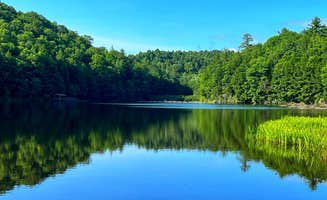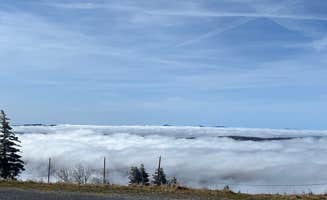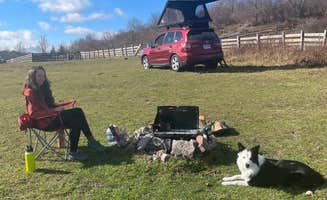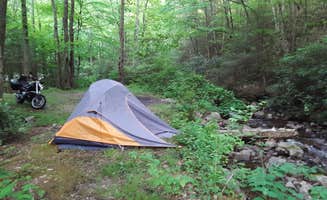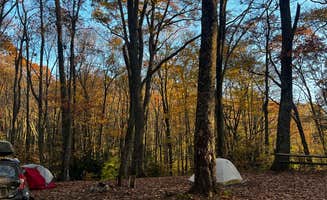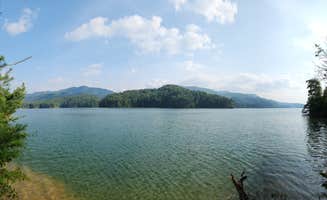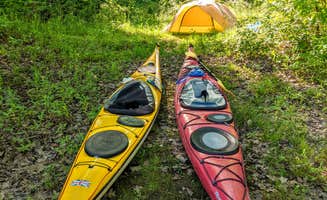The Washington and Jefferson National Forests contain numerous dispersed camping areas around Chilhowie, Virginia. Located within the Blue Ridge Mountains at elevations between 2,000-5,000 feet, the region experiences cool summer nights with temperatures often dropping into the 50s even during July and August. Many primitive camping options near Chilhowie, Virginia require campers to bring everything needed for their stay as most sites lack basic amenities beyond established fire rings.
What to do
Hiking to waterfalls: Access multiple waterfalls near Little Tumbling Creek where visitors can enjoy both cascade views and fishing opportunities. One camper noted, "Waterfalls on way up and good fishing along the way in tumbling creek."
Stargazing on high peaks: The elevated locations offer exceptional night sky viewing opportunities at Whitetop campground. A visitor shared, "Watching the sunset was spectacular, then being able to star gaze."
Lake activities: Visit nearby lake destinations for water recreation within the national forest. At Hidden Valley WMA, campers report, "Lake is calm and clean for water recreation," making it ideal for paddling, fishing and swimming during warmer months.
What campers like
Above-cloud experiences: Morning views from elevated campgrounds often put campers above the cloud line. A visitor at Whitetop described, "As we're getting ready to head out for the day, all of a sudden the sun came out and we were ABOVE THE CLOUDS. It was absolutely stunning."
Creek sounds: Many campers appreciate the ambient water sounds at primitive sites near Chilhowie. At Little Stony Creek Road Dispersed Area, reviewers mention, "beautiful streams and mountains" as standout features.
Seclusion: The off-grid nature of these backcountry sites creates true isolation from modern distractions. One camper at Mount Rogers National Recreation Area shared, "This spot is incredible. Free spot, right next to a gorgeous creek. It was totally empty in March - we didn't see a single soul."
What you should know
Road conditions: Many forest roads require careful driving and appropriate vehicles. A visitor to Scales Trailhead Basecamp warned, "The road in is....'rocky'. High clearance 4wd needed. Not ADV friendly, unless you're very adventurous."
No cell service: Most camping areas have zero connectivity. One camper stated, "Small site right by road and creek...Absolutely no verizon service at the site."
Weather extremes: Exposed mountain sites experience intense weather conditions. A Whitetop visitor cautioned, "The wind is killer. We ended up moving our tent to the other side of the car park at the top. There's a nice little piney forest which provided a little shelter from the wind."
Safety awareness: Some remote areas attract various visitors. One camper warned, "There also are a few peculiar (methy) characters that come in and out of the parking lot at night."
Tips for camping with families
Use established campsites: For families new to backcountry camping, choose sites with some basic infrastructure. A camper suggested, "Right next to the road, so first time campers would feel safe. The creek's sound is pleasant."
Pack water filters: With no potable water available, families need reliable filtration systems. One reviewer noted, "Plenty of dead wood for fires. Trash cans available. Rocks for fire pits and no tables."
Consider wildlife encounters: The region's famous wild ponies can be a highlight for children. A camper at Scales Trailhead explained, "Our favorite parts are the beautiful views, wild ponies, & it's (usually) relatively quiet!"
Plan for temperature swings: Mountain elevations mean significant day-to-night temperature drops, even in summer. Pack extra layers as temperatures can drop to the 40s overnight during summer months.
Tips from RVers
Limited options for large vehicles: Most dispersed camping areas aren't suitable for larger RVs. A Hidden Valley WMA visitor explained, "Our short bus Skoolie had some troubles with it," when referencing the steep grades on forest roads.
Plan for self-sufficiency: With no hookups or dump stations, RVers must be completely self-contained. Bring enough water and plan for waste management throughout your stay.
Park strategically: When camping in more exposed areas, position your vehicle to block prevailing winds. This creates a wind barrier for tents or outdoor seating areas in the often-windy mountain terrain.


